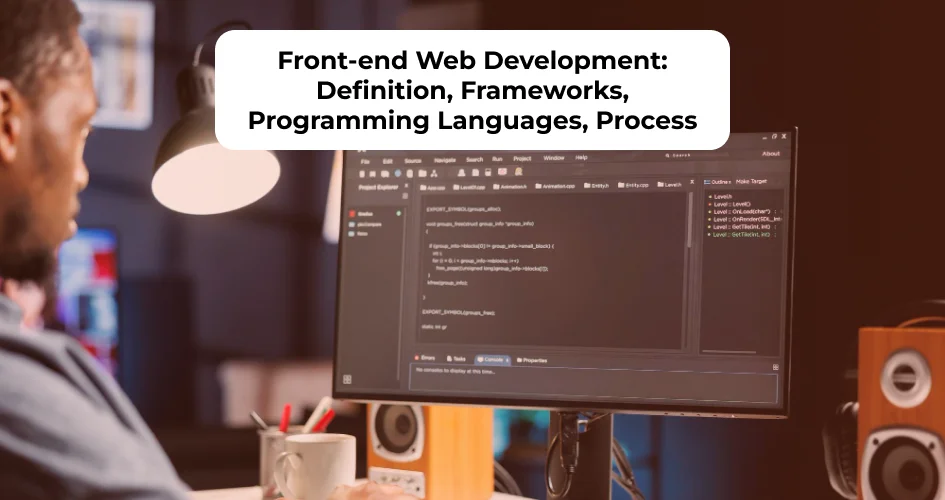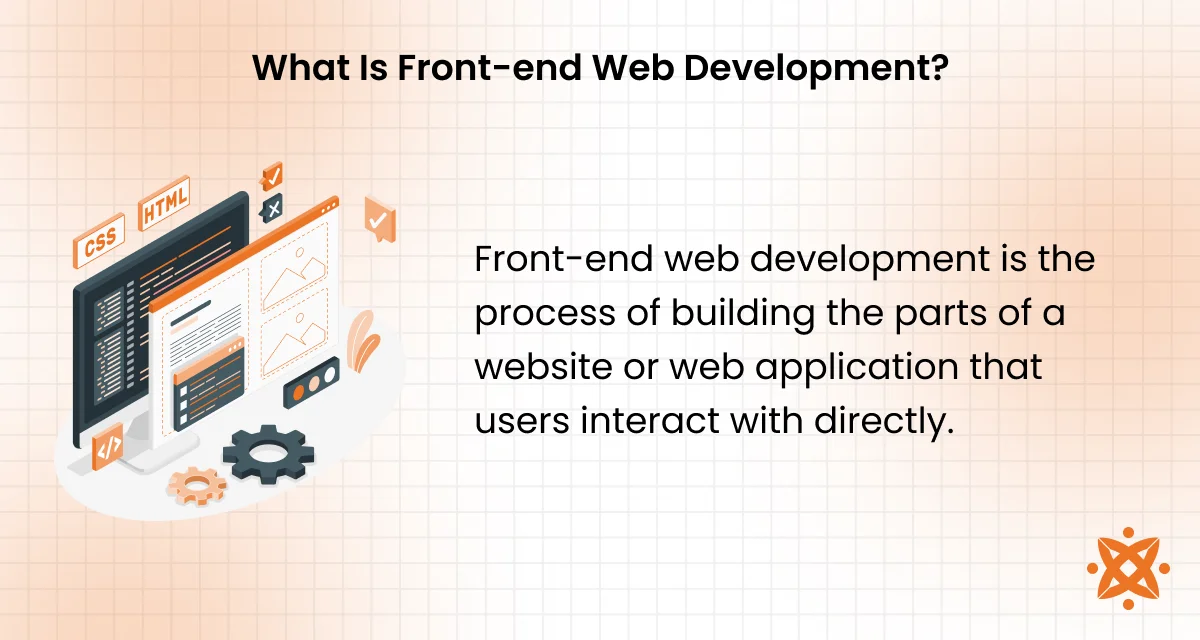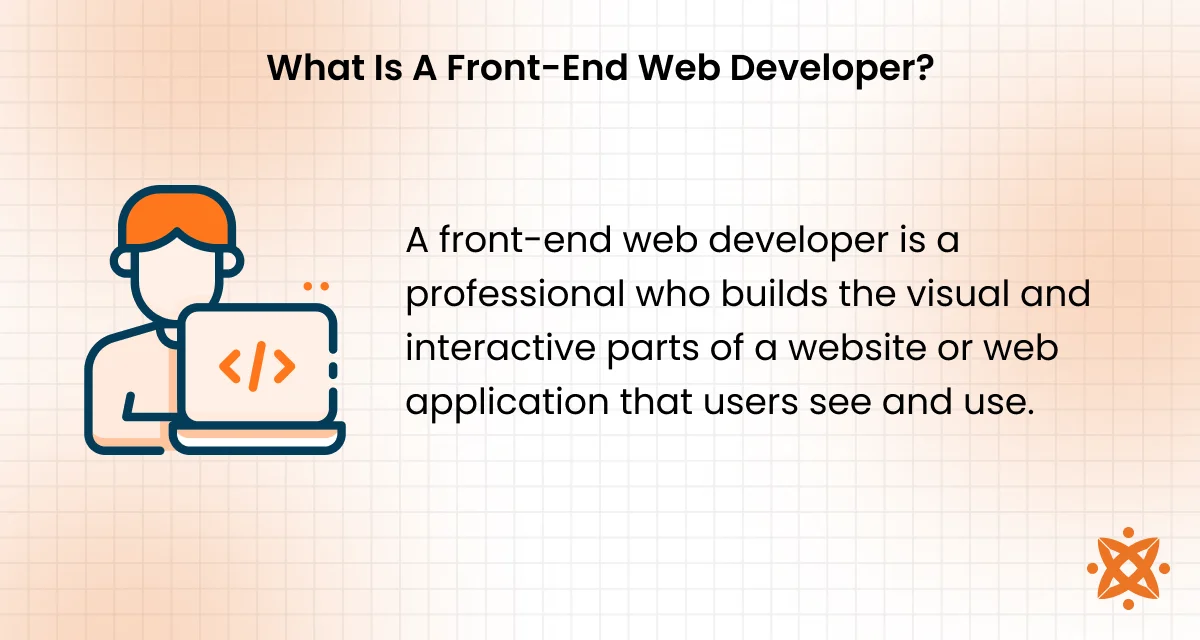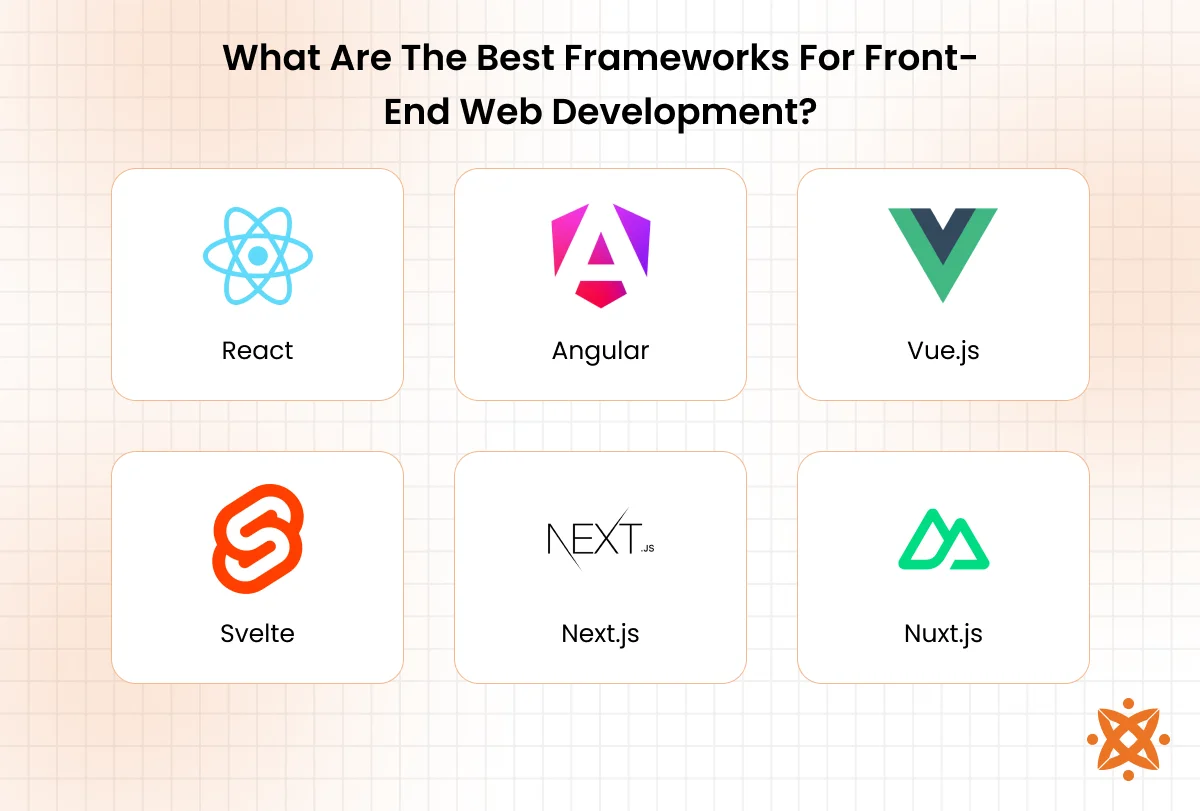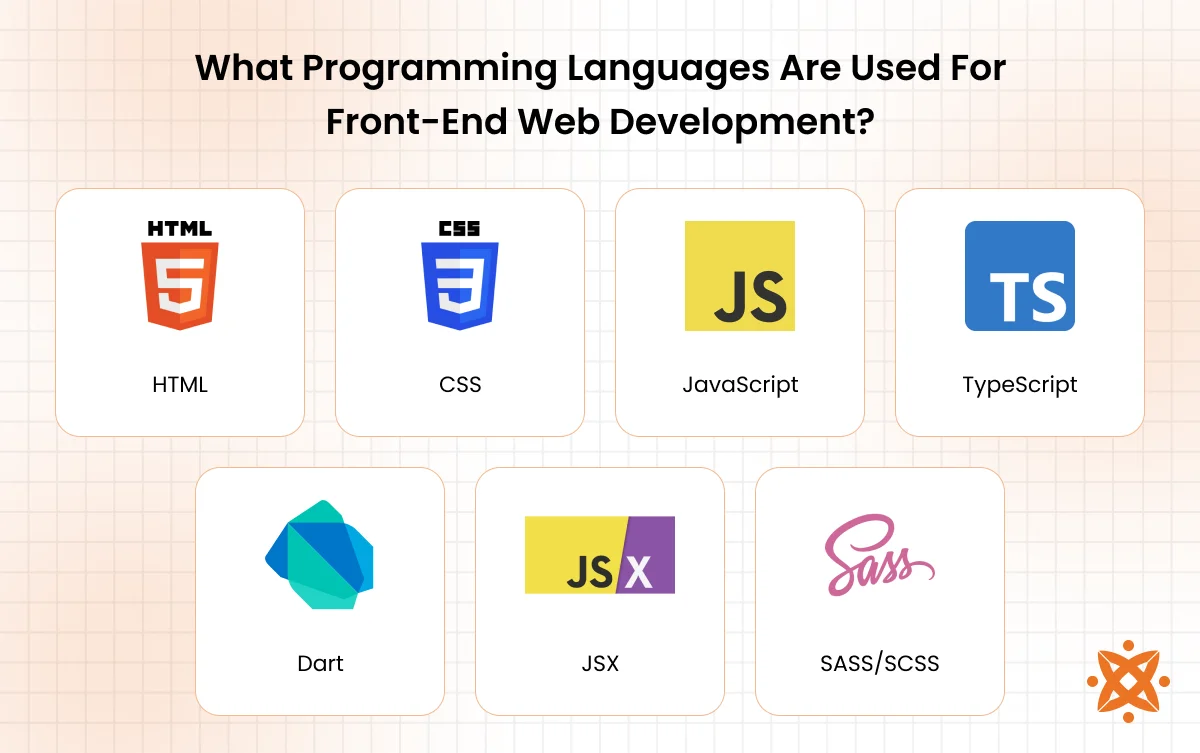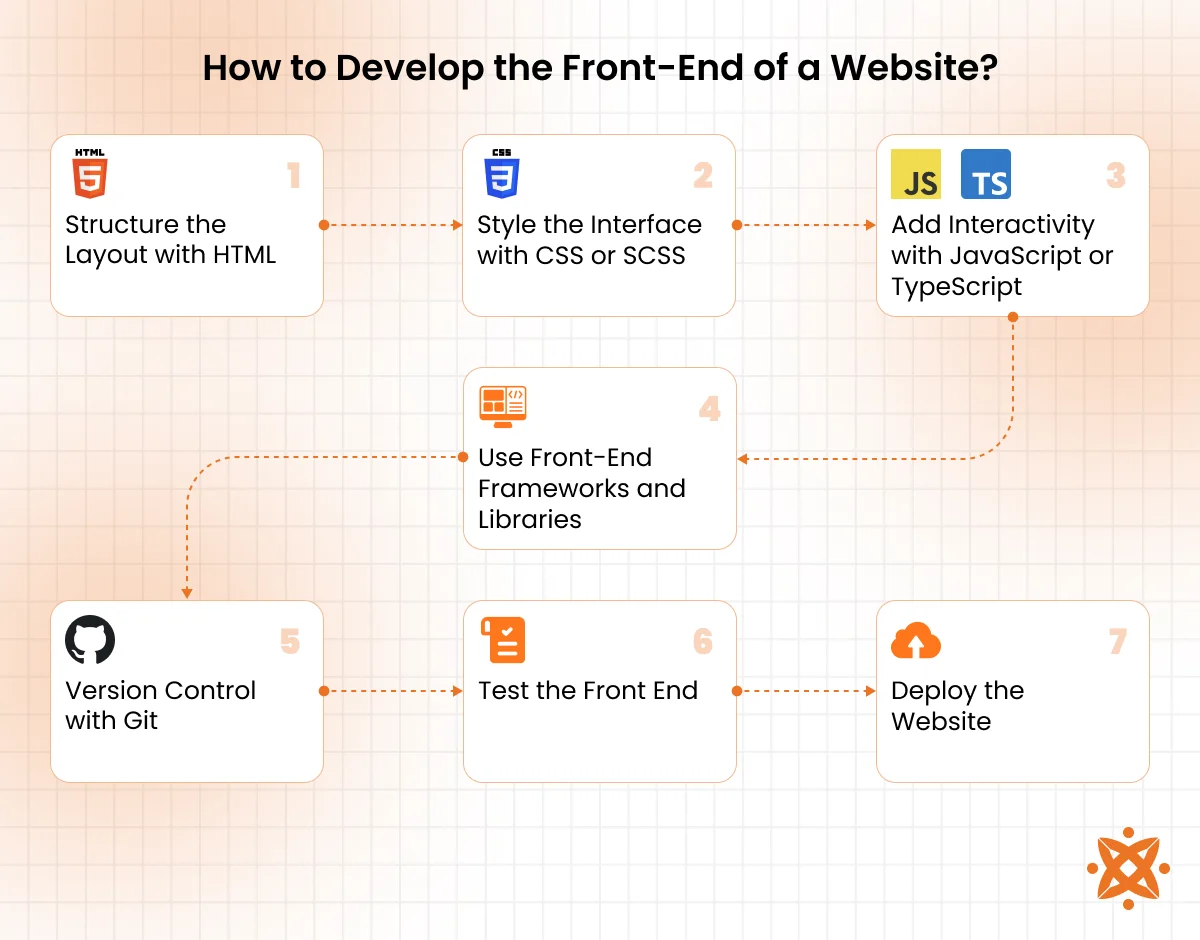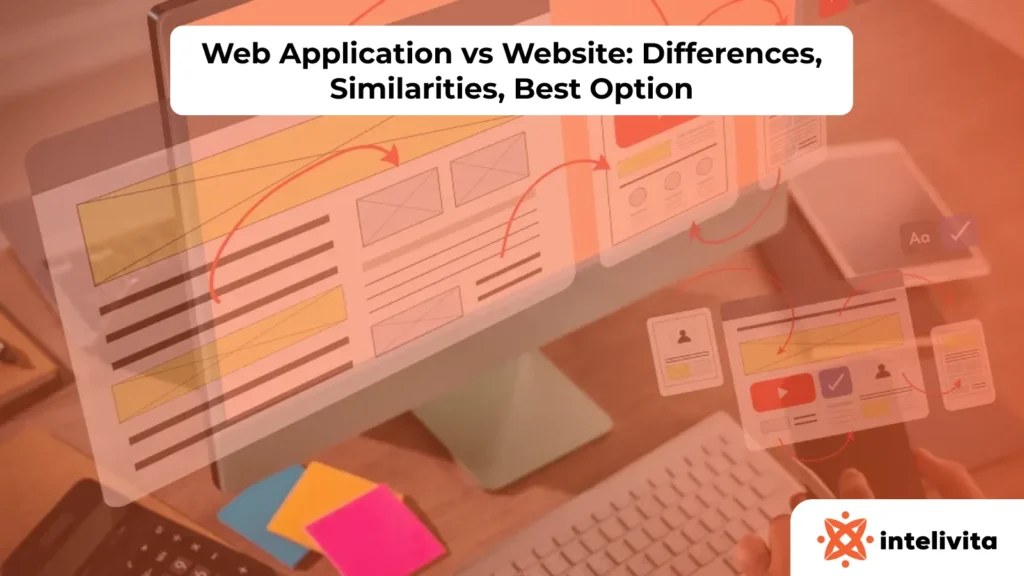Front-end web development focuses on building the visual and interactive elements of a website or web application that users engage with directly. It plays a key role in shaping the user experience by using HTML, CSS, JavaScript, and modern developer tools to deliver responsive, accessible, and fast-loading interfaces.
The best frameworks and tools for front-end development include React, Angular, Vue.js, and Svelte for building UI components. These frameworks help improve productivity and scalability, while tools like Git (version control) and GitHub streamline collaboration.
Languages used in front-end development are HTML, CSS, JavaScript, TypeScript, Dart, JSX, and SASS/SCSS. JavaScript and TypeScript dominate the stack for interactivity and logic, while HTML and CSS structure and style the web application.
The front-end development process begins by building a structure using HTML, styling it with CSS or Sass, and adding interactivity with JavaScript or TypeScript. Frameworks like React and Vue are used for component management, and the final application is tested, versioned with Git, and deployed using platforms like Netlify or Vercel.
According to the U.S. Bureau of Labour Statistics, web developer employment, including front-end roles, is projected to grow 16% from 2022 to 2032, which is much faster than average.
What Is Front-end Web Development?
Front-end web development is the process of building the parts of a website or web application that users interact with directly. This includes everything you see on the screen, such as text, images, buttons, menus, animations, and the overall layout.
Front-end web development is built using a combination of HTML (for structure), CSS (for design), and JavaScript (for interactivity). The front end is what brings your brand, product, or service to life visually and functionally in a browser.
This part of development is important because it shapes the user experience (UX) and determines how users engage with your platform. A well-built front end loads quickly, adapts to different screen sizes, feels intuitive, and visually aligns with your business identity.
Poor front-end design, on the other hand, causes users to bounce from your site within seconds, impacting conversions, customer trust, and SEO rankings.
Use cases for front-end development include marketing websites, e-commerce stores, SaaS dashboards, blogs, landing pages, internal tools, and mobile-responsive interfaces. Whether you’re building a single-page application or a complex web platform, front-end development is what turns your concept into something real that people can see and use.
What Is A Front-End Web Developer?
A front-end web developer is a professional who builds the visual and interactive parts of a website or web application that users see and use. They translate design files and business ideas into clean, responsive code using HTML, CSS, and JavaScript, enhanced with frameworks like React, Angular, or Vue.
What front-end developers do goes beyond writing code, they ensure the site looks good, functions smoothly across all devices, loads fast, and responds well to user actions like clicks or form inputs. They also work closely with designers, back-end developers, and project managers to bring a product to life in the browser.
To be effective, a front-end developer should have strong skills in HTML, CSS, and JavaScript, plus experience with frameworks, responsive design, version control systems (like Git), and debugging tools. Understanding UI/UX principles, browser compatibility, and accessibility standards is also essential for delivering high-quality, user-friendly interfaces.
What Are The Best Frameworks For Front-End Web Development?
The best frameworks for front-end web development include React, Angular, and Vue, each offering powerful tools to build fast, responsive, and modern user interfaces. These frameworks help developers manage complex UI structures, improve performance, with reusable components and state management.
Here are the most effective frameworks in front-end development:
- React: React is a JavaScript library developed by Facebook in 2013 for building user interfaces. It uses JavaScript and JSX, making it ideal for single-page applications. React is widely adopted, relatively easy to learn, and works with tools like npm, Vite, and Create React App.
- Angular: Angular is a TypeScript-based front-end framework maintained by Google, first released in 2010. It’s great for building large-scale, enterprise-grade applications. It comes with a powerful CLI and built-in solutions for routing, forms, and testing, but has a steeper learning curve.
- Vue.js: Vue.js is a progressive JavaScript framework created by Evan You in 2014, designed to be approachable and flexible. It uses JavaScript and a component-based model similar to React. Vue is lightweight, beginner-friendly, and integrates well with tools like Vue CLI and Vite.
- Svelte: Svelte is a newer JavaScript framework developed by Rich Harris in 2016 that compiles your code into efficient JavaScript at build time. It uses a simplified syntax and doesn’t require a virtual DOM, making it fast and easy to use. Svelte requires tools like Vite or Rollup for bundling.
- Next.js: A React-based framework developed by Vercel for building fast, SEO-friendly React applications with server-side rendering and static generation. It uses JavaScript or TypeScript and works best with the Vercel deployment platform, but also supports custom servers.
- Nuxt.js: A Vue-based framework similar to Next.js, created for building scalable, server-rendered Vue applications. It uses JavaScript and works with Vue’s ecosystem. Nuxt simplifies routing, rendering, and SEO optimization, and is compatible with tools like Vue CLI and Vite.
What Programming Languages Are Used For Front-End Web Development?
The programming languages used for front-end websites include HTML, CSS, JavaScript, and TypeScript. HTML structures the content, CSS styles it, JavaScript adds interactivity, and TypeScript brings added safety and clarity to larger, more complex front-end codebases.
Here’s the most commonly used programming languages used for front-end development:
- HTML: HTML (HyperText Markup Language) is the backbone of all web content. It structures elements like headings, text, images, and links. It’s simple to learn but limited to layout and content structure.
- CSS: CSS (Cascading Style Sheets) controls the visual design of a website, including colors, spacing, fonts, and responsiveness. It’s powerful for styling but becomes hard to manage in large projects without frameworks or preprocessors.
- JavaScript: JavaScript brings interactivity to websites, such as dropdowns, sliders, and animations. It’s essential for dynamic content and widely supported, but managing complex codebases without a framework can get messy.
- TypeScript: TypeScript is a superset of JavaScript that adds static typing. It helps catch bugs early and improves code readability in large-scale apps, though it has a steeper learning curve for beginners.
- Dart: Dart is a programming language developed by Google, mainly used with the Flutter framework for web and mobile UI. It’s fast and reactive but less commonly used in traditional web development projects.
- JSX: JSX (JavaScript XML) is a syntax extension used in React that lets you write HTML-like code within JavaScript. It makes UI code more readable and intuitive but requires build tools like Babel to compile.
- SASS/SCSS: SASS and SCSS are CSS preprocessors that add features like variables, nesting, and mixins to standard CSS. They help organize styles in large projects but require a compiler to convert the code into regular CSS.
How to Develop the Front-End of a Website?
To develop the front-end of a website, create the front-end structure with HTML, style the structure, and add interactivity with JavaScript or TypeScript. Developers use frameworks like React or Vue, version control tools like Git, and testing tools like Cypress or Jest to ensure quality and performance.
The steps to develop the front-end of a website involves the following:
1. Structure the Layout with HTML
Start by using HTML (HyperText Markup Language) to build the foundation of the webpage. This includes defining headings, paragraphs, images, links, forms, and other content elements. HTML provides the structure that everything else is built on.
2. Style the Interface with CSS or SCSS
Once the structure is in place, CSS is used to control how the website looks—colors, fonts, layout spacing, and responsiveness. Developers may also use SCSS (a CSS preprocessor) for cleaner, more manageable code with features like variables and nesting.
3. Add Interactivity with JavaScript or TypeScript
JavaScript brings the interface to life by adding behaviors like animations, form validation, and dynamic content loading. TypeScript, a superset of JavaScript, adds static typing and makes larger codebases easier to manage and debug.
4. Use Front-End Frameworks and Libraries
Frameworks like React, Vue, or Angular speed up development by offering reusable components and built-in state management. These tools help manage complex interfaces and improve performance.
5. Version Control with Git
Git is used to track changes in the codebase and collaborate with other developers. Platforms like GitHub or GitLab make it easy to manage branches, pull requests, and code reviews.
6. Test the Front End
Use testing tools like Jest, Mocha, or Cypress to ensure everything works correctly across different browsers and devices. Testing helps catch bugs early and ensures a consistent user experience.
7. Deploy the Website
Finally, the website is deployed using platforms like Vercel, Netlify, or traditional hosting providers. This makes the site live and accessible to users around the world.
What is the Difference Between Front-end Web Development and Back-end Web Development?
The main difference between front-end web development and back-end web development is that front-end focuses on what users see and interact with, while back-end handles the server-side logic, database operations, and data processing that power the application.
Front-end development works with tools like HTML, CSS, JavaScript, and UI frameworks to create a smooth user experience, while back-end development uses languages like Python, PHP, or Java to build APIs, manage databases, and handle authentication.
In full-stack development, both roles are combined to deliver a complete, functional web application from end to end.
What is the Difference Between Front-end Web Development and Web Development?
The main difference between front-end web development and web development is scope, front-end is a subset of web development.
Front-end development deals strictly with the user interface and experience, while web development is a broader term that includes front-end, back-end, full-stack development, and even DevOps.
A web developer could specialize in any layer of a web application, whereas a front-end developer specifically builds what the user sees and interacts with in the browser.
How to Choose the Right Front-end Web Developer for Your Website?
To choose the right front-end web developer for your website, look for strong skills in HTML, CSS, JavaScript, and experience with modern frameworks like React or Vue. Also consider their ability to deliver responsive design, collaborate with designers and back-end teams, and write clean, maintainable code.
Here are key tips to help you hire the right front-end web developer for your website:
- Review their portfolio: Look for responsive, interactive, and clean websites that match the style and function you want.
- Check technical skills: Ensure they’re proficient in HTML, CSS, JavaScript, and familiar with frameworks like React, Vue, or Angular.
- Test their understanding of UX/UI: A good front-end developer should know how to design interfaces that are both attractive and user-friendly.
- Assess communication and collaboration: They should be able to explain their work clearly and work effectively with designers and back-end developers.
- Ask about tools and workflow: Look for experience with version control (Git), testing tools (like Jest or Cypress), and deployment platforms like Vercel or Netlify.
- Look for mobile-first experience: Make sure they can build fully responsive websites that perform well on all devices.
Hiring the right front-e developer ensures your website is modern, user-focused, and built for performance from day one.
Need expert help? Consider Intelivita for the best front-end web development services in the USA and near you. They bring years of experience, work with the latest technologies, and deliver scalable, mobile-responsive websites that convert.
What Is The Cost Of Front-End Web Development?
The average cost of front-end web development is between $3,000 and $20,000, depending on the complexity, design requirements, and features of the website. Simple websites with basic layout and static content cost less, while dynamic, interactive interfaces or apps with animations, custom UI components, and responsiveness across all devices cost significantly more.
Factors that influence the price include the number of pages, level of design customization, use of front-end frameworks like React or Vue, developer experience, timeline, and whether you’re hiring a freelancer or a professional agency. Ongoing costs also include updates, maintenance, and performance optimization.
What Are The Best Practices For Front-End Web Development?
The best practices for front-end web development include writing clean, modular code, optimizing for performance and accessibility, and ensuring mobile responsiveness. It’s also important to follow consistent naming conventions, use version control like Git, and test your interface across multiple browsers and devices.
Here are the top best practices for front-end development you should follow to build high-quality, user-friendly websites:
- Write clean, modular code: Break your code into reusable components and follow consistent formatting and naming conventions.
- Use semantic HTML: Properly structure content using tags like <header>, <main>, and <footer> to improve accessibility and SEO.
- Optimise for performance: Minimize CSS and JavaScript, lazy-load images, and use caching techniques to speed up load times.
- Design for mobile first: Start with mobile layouts and scale up to larger screens to ensure responsive design across devices.
- Ensure accessibility: Follow WCAG guidelines, use ARIA labels, and support keyboard navigation to make your site usable for all users.
- Leverage version control: Use Git and platforms like GitHub or GitLab to track changes and collaborate efficiently.
- Use testing tools: Run automated tests with tools like Jest, Cypress, or Mocha to catch bugs early.
- Document your code: Write clear comments and maintain developer documentation for easier future updates and collaboration.
- Stay up to date: Regularly learn new features, tools, and frameworks to keep your skills and projects current.
- Deploy smartly: Use modern deployment platforms like Vercel or Netlify for smooth, scalable, and fast hosting.
What Are The Trends In Front-End Web Development?
The trends in front-end web development are component-based frameworks like React and Vue, increased use of static site generators like Next.js and Nuxt.js, and deeper integration of AI-powered developer tools. There’s also a growing shift toward performance-first design, accessibility by default, and the use of micro frontends for large-scale web applications.
The top trends in front-end web development are explained below:
- Component-Based Frameworks: Tools like React, Vue, and Svelte let developers build UIs using reusable components, making code easier to manage and scale.
- Static Site Generators: Frameworks like Next.js and Nuxt.js are leading the rise of static site generation, offering better performance and SEO with dynamic capabilities through APIs.
- AI-Powered Developer Tools: Platforms like GitHub Copilot and Codeium help speed up coding by offering intelligent suggestions and automating repetitive tasks.
- Micro Frontends: This architecture breaks large front-end applications into smaller, manageable parts, allowing teams to work independently and deploy faster.
- Performance-First Design: There’s increased emphasis on building lightweight, fast-loading sites that work well on all devices, especially with Google’s Core Web Vitals influencing search rankings.
- Accessibility by Default: Developers are now expected to follow WCAG standards and build interfaces that work for users with all abilities right from the start.
- CSS-in-JS and Utility-First CSS: Tools like Tailwind CSS and styled-components are changing how styles are written, making code more dynamic, reusable, and maintainable.

